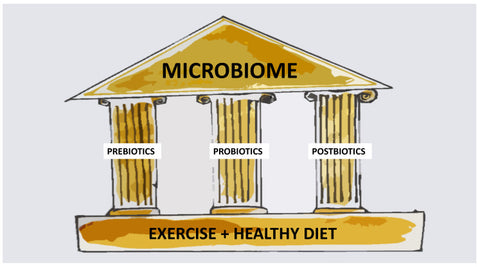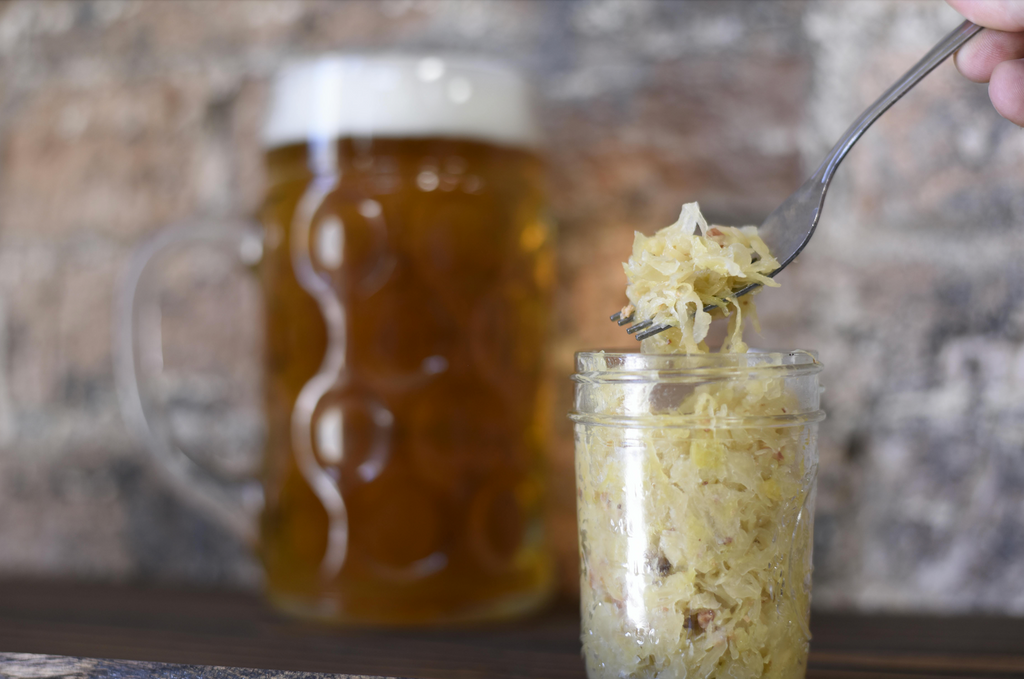After fasting to drastically reduce the number of bacteria in our gut and sealing to restore the gut lining, it's important to give our gut microbiome a kickstart by seeding it with gut-beneficial bacteria. Don’t leave this part to chance.
What Should I Eat First?
Take care in deciding what food should be put into a purified gut. Whatever we put into our gut first is what starts the garden growing, so to speak. Our gut garden is freshly weeded, cleared, fertilised, and ready to be planted in. We obviously don’t want to plant the seeds of junk food. Just eating fresh fruits and vegetables and hoping the bacteria will take care of themselves is also not the best option, and here’s why.
In 2021 a group of scientists from Stanford took 2 groups of healthy people to study their inflammatory markers and microbiome diversity. Over 14 weeks, one group of subjects added extra high-fibre foods (including fresh fruits and veggies) to their existing diet. The other group added low-sugar fermented foods to their existing diet (including properly fermented sauerkraut, kimchi, miso, etc. The refrigerated kind, not the cheap imported or tinned stuff). Throughout the study, the inflammatory markers and gut microbiome diversity of the participants were measured. Notably, the high-fibre group had increased inflammation and a decreased microbiome diversity. Significantly, the low-sugar-fermented-food group had decreased inflammation and a much broader microbiome diversity.

High Fibre Diet vs High Fermented Food Diet
Fermented Foods are Essential
This is all to say that seeding our gut with probiotic foods is essential for a diverse and resilient gut microbiome, this also has the bonus effect of decreasing system inflammation. Don’t get the wrong idea, fresh fruits and vegetables are also important to eat. The thing is that fresh fruits and vegetables are made up of non-digestible plant fibres (prebiotics) which our body can’t break down, however, our gut microbiome can. It’s probable that the high-fibre participants didn’t have the gut bacteria to deal with all the extra fibre in their new diet. They were feeding bacteria that they didn’t have. Let's make sure that we have the probiotics in our gut by first eating fermented foods before we go overboard on the fruit and veg. This is how essential it is to Seed our gut.
Fermented Foods Are Probiotic
Fermented foods have been a part of every traditional culture throughout recorded history. Even in our own country, indigenous Australians were known to ferment toxic foods such as cycads to make them a palatable and beneficial part of their diet. Traditionally fermented foods work wonders for our gut.
We know that fermented foods are high in gut-beneficial bacteria. Research has shown that Portuguese cabbage, when wildly fermented for more than 7 days, can have nearly 1,000,000,000 (1 Billion) bacteria per gram. The same study specifies that vegetables that are higher in sugar, such as drumhead cabbage, carrots, and beetroot, provide more readily available food for the bacteria and therefore produce a more probiotically dense fermented vegetable product.
Fermented foods have also been shown to contain greater bacterial diversity than probiotic pills. Many different types of fermented foods have been tested to contain living bacteria including:
- Kvass
- Miso
- Kimchi
- Fermented beetroot
- Fermented cucumbers
- Fermented ginger
- Sauerkraut
- Fermented olives
- Fermented beans
- Milk kefir
- Kombucha
Fermented Foods can also be Prebiotic
We know that naturally fermented foods can contain prebiotics (the food that the probiotics feed on). When we think of fermented food like sauerkraut or kimchi, the fresh vegetables have transformed into an ideal environment for the good bacteria to thrive on their favourite food, multiplying abundantly in the process. Especially when the fermented food is based on fruit, vegetables, legumes, or nuts we can be sure that there is still plenty of prebiotics left to feed the bacteria in our gut.
Fermented Foods are Postbiotic
The latest fermentation “miracle” that scientists are currently talking about is postbiotics. Postbiotics are the by-products produced when probiotics feed on prebiotics and multiply. Postbiotics are thought to be where most of the benefits attributed to probiotics come from. Some parts of postbiotics include vitamins like K2 and B, short-chain fatty acids (helping good bacteria thrive), and antimicrobial peptides (inhibiting bad bacteria from thriving). The area of postbiotics is pretty new; they are known to be highly anti-inflammatory, and guess what? They can be bought as a supplement, however, they’re pretty expensive. The incredible thing about fermented foods like sauerkraut, kimchi, and miso is that they are also extremely high in postbiotics. The longer food has been fermented, the more postbiotics exist with the food. Isn’t it amazing that we can achieve our daily recommended intake of probiotics, prebiotics, and postbiotics by just consuming fermented foods on a daily basis?

The Pillars to a Diverse Microbiome
Fermented Foods are Acid Resistant
Sauerkraut and other probiotic foods contain a thriving ecosystem of beneficial bacteria. During the process of fermentation, the good bacteria multiply and propagate as they feed on the food available to them. One by-product of fermentation is acid, this means the bacteria that thrive in fermented foods have to be resistant to acid. There are whole groups of bacteria known as lactic acid bacteria, many of these lactic acid bacteria are produced in every fermented food. Research shows that since fermented food bacteria thrive in an acidic environment, they are also resistant to the acidic environment of the stomach and able to pass through our stomach acid to safely reach our intestines.
The Problem with Probiotic Capsules
While it’s convenient to pop a pill (or three) and get on with life, there are some problems and uncertainties with probiotic capsules.
First, we can’t be 100% sure that probiotic capsules even contain the diverse strains of bacteria that the label says they do. In one UK study, only 3 out of the 7 commercially available probiotics examined contained the claimed number of probiotics, others contained substantially less. In an Italian study evaluating 41 probiotic supplements available in Italy, scientists found that only 5 of the 41 probiotic supplements contained all the different species of bacteria that they claimed. The same study tested 24 samples, thirteen months after production and found that only 1 of the 24 samples had the same composition of bacteria as that taken from the manufacturer on day one.
For these two studies, the probiotics were transported and stored according to label specifications...what if the capsules are not stored or transported correctly? High temperatures and UV light are known to be disastrous for the health of bacteria isolated from their natural habitat.
Second, even if the probiotic capsules reach us alive, will they pass through our stomach acid unharmed, ready to work in our intestinal tract?
Thirdly, probiotic capsules don’t come with a handy source of prebiotics and postbiotics.
Why not eat a variety of fermented foods to get living probiotics with the required prebiotics and a bonus dose of postbiotics? Ancestors from every culture did this for thousands of years. Who knows what else we’re missing if we pop a prebiotic pill, followed by a probiotic pill, followed by a post-biotic pill.
What Do We Need to Know When Buying Fermented Food?
- Buy Australian made ferments - imported products have to be pasteurised, which kills off all the good bacteria.
- Buy from the fridge section - living products usually won’t be stored at room temperature as they’ll keep on fermenting, create lots of gas as a by-product and explode.
- Make sure the fermented food is raw and unpasteurised - fermented foods such as sauerkraut and kimchi might taste just as good after pasteurisation, they may also contain the same number of prebiotics and postbiotics, but the probiotics will all be dead from the high-temperature pasteurisation.
- Buy organic if possible - chemicals and fertilisers are no good for the bacteria or us.
- Buy products that have been fermented for as long as possible, the longer the better - we find that for veggies, a month of fermentation seems to be the sweet spot, this means that there are more probiotics and postbiotics available.
- Make sure there’s no sugar or vinegar in the ingredients list - these ingredients indicate that long, traditional fermentation has not taken place. Sugar and vinegar approximate the fermented food flavour without any of the other benefits.
- Avoid fermented food that has been fermented in plastic - the most common, modern fermentation vessel-material is plastic. Fermenting food can get to a pH as low as 3 and can leach invisible and tasteless endocrine-disrupting chemicals into the ferments if plastic barrels are used. Make sure to buy food fermented in chemica- free fermentation vessels such as glass, ceramic crocks with food-safe glaze, or oak barrels.
- Buy ferments that are wildly fermented - ferments that have been fermented with specific cultures are usually lower in bacteria diversity and count. Wildly fermented veggie ferments rely on the diversity of gut-friendly bacteria found on the surface of the vegetables which differs depending on the type of veggie, seasons, and soil type. By consuming wildly fermented veggie ferments we expose our gut to a diversity of microbes that thrive in a range of seasonal temperatures and soil types.
You can make your own or buy from our extensive range of fermented food from Gutsy. If you’re new to fermented foods, get started with sauerkraut or kimchi. We’re passionate about crafting the most probiotic, postbiotic, and tasty fermented foods through chemical-free, oak barrel fermentation.




